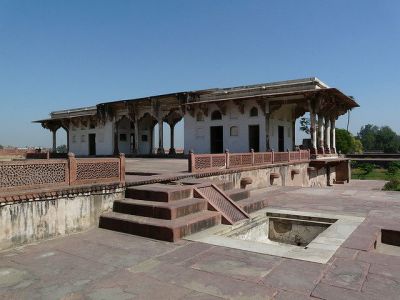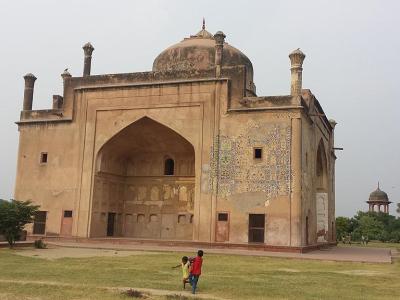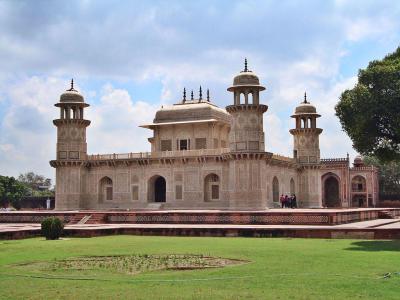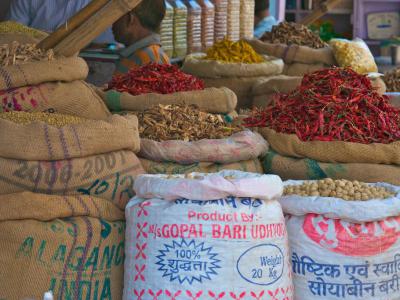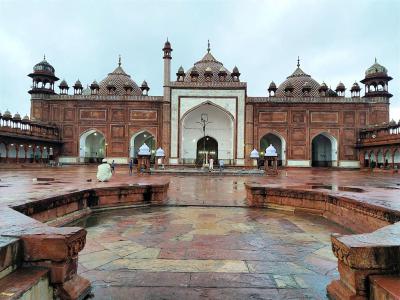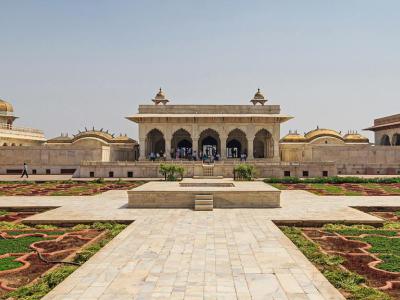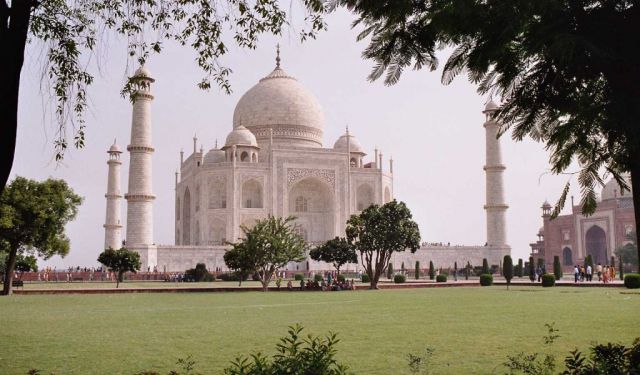Agra Introduction Walking Tour (Self Guided), Agra
Agra, the former capital of India under the powerful Mughal emperors, today is perhaps India's most popular tourist destination, in large part due to the magnificent Taj Mahal located here. Still, other than the iconic mausoleum, Agra is renowned for its colossal historic heritage manifested in numerous sites. To find out what else the city has to offer, take this orientation walk!
How it works: Download the app "GPSmyCity: Walks in 1K+ Cities" from Apple App Store or Google Play Store to your mobile phone or tablet. The app turns your mobile device into a personal tour guide and its built-in GPS navigation functions guide you from one tour stop to next. The app works offline, so no data plan is needed when traveling abroad.
Agra Introduction Walking Tour Map
Guide Name: Agra Introduction Walking Tour
Guide Location: India » Agra (See other walking tours in Agra)
Guide Type: Self-guided Walking Tour (Sightseeing)
# of Attractions: 6
Tour Duration: 3 Hour(s)
Travel Distance: 6.2 Km or 3.9 Miles
Author: leticia
Sight(s) Featured in This Guide:
Guide Location: India » Agra (See other walking tours in Agra)
Guide Type: Self-guided Walking Tour (Sightseeing)
# of Attractions: 6
Tour Duration: 3 Hour(s)
Travel Distance: 6.2 Km or 3.9 Miles
Author: leticia
Sight(s) Featured in This Guide:
- Ram Bagh
- Chini ka Rauza
- Tomb of Itimad-ud-Daula
- Kinari Bazaar
- Jama Masjid
- Agra Fort
1) Ram Bagh
Ram Bagh is one of the oldest Mughal gardens, built during the reign of Emperor Babur in the early 16th century. It is laid out in the traditional Persian-style charbagh pattern, which divides the garden into four main sections with water channels running between them. The pathways and flowing water were designed to represent paradise, a common theme in Mughal garden design. The garden’s structure and layout offer a glimpse into the early landscaping traditions that influenced later gardens of the Mughal period.
Walking through Ram Bagh, visitors can see raised terraces, stone pavilions, and remnants of watercourses that once kept the area cool. The garden was not only a place for leisure but also served as a space for reflection and rest for the emperors who visited it.
The symmetrical design and geometric planning show the Mughal preference for order and harmony in nature. While some parts of the garden have changed over time, the overall structure still reflects Babur’s original vision.
Many travelers find Ram Bagh quieter compared to other historic sites. The open lawns and shaded trees make it a comfortable place to walk or sit and take in the atmosphere. Small stone platforms and seating areas are scattered throughout, giving visitors a chance to pause and appreciate the balance between architecture and greenery.
Though centuries old, the garden remains a simple and peaceful reminder of the Mughals’ interest in combining beauty, functionality, and the natural landscape.
Walking through Ram Bagh, visitors can see raised terraces, stone pavilions, and remnants of watercourses that once kept the area cool. The garden was not only a place for leisure but also served as a space for reflection and rest for the emperors who visited it.
The symmetrical design and geometric planning show the Mughal preference for order and harmony in nature. While some parts of the garden have changed over time, the overall structure still reflects Babur’s original vision.
Many travelers find Ram Bagh quieter compared to other historic sites. The open lawns and shaded trees make it a comfortable place to walk or sit and take in the atmosphere. Small stone platforms and seating areas are scattered throughout, giving visitors a chance to pause and appreciate the balance between architecture and greenery.
Though centuries old, the garden remains a simple and peaceful reminder of the Mughals’ interest in combining beauty, functionality, and the natural landscape.
2) Chini ka Rauza (must see)
Chini ka Rauza is a 17th-century mausoleum that stands as a distinctive example of Indo-Persian architecture and artistry from the Mughal period. Built in 1635, it serves as the tomb of Allama Afzal Khan Mullah, a scholar, poet, and the prime minister of the Mughal emperor Shah Jahan. The structure’s name translates to “Tomb of China” or “Chinese Tomb,” a reference not to the country but to the glazed tile work, or chini, that decorates its façade. These vivid, hand-painted tiles—imported from Persia—make the monument one of the earliest and most striking examples of glazed tile ornamentation in Mughal India.
The building’s architecture combines Persian, Central Asian, and Indian influences, reflecting the cosmopolitan nature of the Mughal court. Constructed primarily from brown sandstone, the mausoleum is crowned with a single dome and framed by slender minarets. The façade is adorned with intricate tile mosaics in shades of turquoise, ochre, and green, many of which still retain traces of their original brilliance despite centuries of weathering.
The interior once featured fine calligraphy and floral motifs, echoing the refined aesthetic of the Mughal elite and symbolizing the spiritual harmony sought by Islamic scholars of the period.
Unlike the grand marble structures commissioned by Shah Jahan, Chini ka Rauza has a quieter, more scholarly character. The surrounding gardens and open courtyards create a serene atmosphere, offering travelers a glimpse into the contemplative side of Mughal architecture—less about imperial grandeur and more about intellectual legacy. From its design and ornamentation, visitors can sense the influence of Persian craftsmanship that shaped much of Mughal India’s artistic vocabulary.
Though time has softened many of its details, Chini ka Rauza remains an important monument for those interested in the evolution of Mughal funerary architecture. It bridges the ornate style of earlier emperors with the more refined marble works that followed, standing as both a historical and cultural link in India’s architectural heritage.
The building’s architecture combines Persian, Central Asian, and Indian influences, reflecting the cosmopolitan nature of the Mughal court. Constructed primarily from brown sandstone, the mausoleum is crowned with a single dome and framed by slender minarets. The façade is adorned with intricate tile mosaics in shades of turquoise, ochre, and green, many of which still retain traces of their original brilliance despite centuries of weathering.
The interior once featured fine calligraphy and floral motifs, echoing the refined aesthetic of the Mughal elite and symbolizing the spiritual harmony sought by Islamic scholars of the period.
Unlike the grand marble structures commissioned by Shah Jahan, Chini ka Rauza has a quieter, more scholarly character. The surrounding gardens and open courtyards create a serene atmosphere, offering travelers a glimpse into the contemplative side of Mughal architecture—less about imperial grandeur and more about intellectual legacy. From its design and ornamentation, visitors can sense the influence of Persian craftsmanship that shaped much of Mughal India’s artistic vocabulary.
Though time has softened many of its details, Chini ka Rauza remains an important monument for those interested in the evolution of Mughal funerary architecture. It bridges the ornate style of earlier emperors with the more refined marble works that followed, standing as both a historical and cultural link in India’s architectural heritage.
3) Tomb of Itimad-ud-Daula (must see)
The Tomb of Itimad-ud-Daula is a marble mausoleum built in the early 17th century for Mirza Ghiyas Beg, a high-ranking official in the Mughal court, and his wife, Nur Jahan’s mother. Often regarded as a precursor to later Mughal architecture, including the Taj Mahal, the tomb is set within a rectangular garden that follows the charbagh layout. Water channels and pathways divide the garden into four quadrants, creating a sense of symmetry and order around the central structure.
The tomb is constructed primarily from white marble and features intricate inlay work with semi-precious stones. Unlike earlier Mughal tombs built mainly of red sandstone, this structure emphasizes detailed decoration and delicate geometric and floral patterns. The walls are covered with pietra dura designs, while lattice screens and carved panels add texture and visual interest. The central chamber contains the cenotaphs of Mirza Ghiyas Beg and his wife, while the actual graves are located in a lower chamber, in keeping with Mughal burial tradition.
Visitors walking through the complex can observe the balance between architectural design and landscaping. The garden provides open spaces, shaded areas, and water features that enhance the overall experience of the tomb.
The layout allows for clear sightlines to the central structure from multiple angles, highlighting the tomb’s proportions and craftsmanship. Small pavilions around the garden provide resting points and additional viewing perspectives for those exploring the grounds.
The Tomb of Itimad-ud-Daula demonstrates a shift in Mughal architecture toward more decorative marble work and detailed artistry. Its combination of ornamental design and functional garden space offers insight into the artistic and cultural priorities of the Mughal period. Visitors can explore the grounds at a relaxed pace, taking in both the elaborate details of the tomb and the carefully planned garden surrounding it.
The tomb is constructed primarily from white marble and features intricate inlay work with semi-precious stones. Unlike earlier Mughal tombs built mainly of red sandstone, this structure emphasizes detailed decoration and delicate geometric and floral patterns. The walls are covered with pietra dura designs, while lattice screens and carved panels add texture and visual interest. The central chamber contains the cenotaphs of Mirza Ghiyas Beg and his wife, while the actual graves are located in a lower chamber, in keeping with Mughal burial tradition.
Visitors walking through the complex can observe the balance between architectural design and landscaping. The garden provides open spaces, shaded areas, and water features that enhance the overall experience of the tomb.
The layout allows for clear sightlines to the central structure from multiple angles, highlighting the tomb’s proportions and craftsmanship. Small pavilions around the garden provide resting points and additional viewing perspectives for those exploring the grounds.
The Tomb of Itimad-ud-Daula demonstrates a shift in Mughal architecture toward more decorative marble work and detailed artistry. Its combination of ornamental design and functional garden space offers insight into the artistic and cultural priorities of the Mughal period. Visitors can explore the grounds at a relaxed pace, taking in both the elaborate details of the tomb and the carefully planned garden surrounding it.
4) Kinari Bazaar (must see)
Kinari Bazaar is a lively marketplace where colors, sounds, and aromas come together to create an atmosphere full of energy and tradition. Known for its narrow, winding lanes lined with centuries-old shops, the bazaar offers a glimpse into the rhythm of local life. Traders call out their wares, and the scent of spices and incense drifts through the air, inviting visitors to slow down and take in every detail.
The market is especially famous for its wedding finery and festive decorations. Rows of shops display embroidered fabrics, silk sarees, jewelry, and ornate accessories used in traditional ceremonies. You’ll find shelves stacked with bangles in every shade imaginable, glittering trims for garments, and delicate zari work that catches the light beautifully.
Beyond clothing, the market also offers decorative items, handicrafts, and small trinkets perfect for souvenirs. Every corner seems to hold something new, and even a casual stroll can turn into a treasure hunt for those with a keen eye.
Exploring Kinari Bazaar is as much about the atmosphere as it is about shopping. Rickshaws weave through the lanes, shopkeepers engage in cheerful bargaining, and local sweets like petha and jalebi tempt passersby from nearby stalls. The mix of voices, colors, and textures creates an experience that’s both sensory and cultural. Visitors can easily spend hours wandering through the maze of alleys, pausing to chat with merchants or sample local treats.
While it can be crowded, that very bustle is part of its charm. The bazaar embodies the spirit of community and craftsmanship, where traditions have been passed down through generations.
The market is especially famous for its wedding finery and festive decorations. Rows of shops display embroidered fabrics, silk sarees, jewelry, and ornate accessories used in traditional ceremonies. You’ll find shelves stacked with bangles in every shade imaginable, glittering trims for garments, and delicate zari work that catches the light beautifully.
Beyond clothing, the market also offers decorative items, handicrafts, and small trinkets perfect for souvenirs. Every corner seems to hold something new, and even a casual stroll can turn into a treasure hunt for those with a keen eye.
Exploring Kinari Bazaar is as much about the atmosphere as it is about shopping. Rickshaws weave through the lanes, shopkeepers engage in cheerful bargaining, and local sweets like petha and jalebi tempt passersby from nearby stalls. The mix of voices, colors, and textures creates an experience that’s both sensory and cultural. Visitors can easily spend hours wandering through the maze of alleys, pausing to chat with merchants or sample local treats.
While it can be crowded, that very bustle is part of its charm. The bazaar embodies the spirit of community and craftsmanship, where traditions have been passed down through generations.
5) Jama Masjid (must see)
Jama Masjid in Agra is one of the largest and most prominent mosques built during the Mughal era. Commissioned by Emperor Shah Jahan in 1648, it was constructed in honor of his beloved daughter, Jahanara Begum, who also oversaw aspects of its design and planning.
The mosque was built as part of the imperial complex surrounding the Agra Fort, serving both as a royal place of worship and as a communal center for the faithful. Its creation reflects the Mughal emphasis on religious devotion, architectural balance, and the blending of artistic traditions from across the empire.
Built primarily from red sandstone with intricate white marble inlay, the structure combines simplicity of form with detailed ornamentation. The main prayer hall is elevated on a high plinth, featuring three graceful domes with alternating stripes of white marble and red sandstone. These domes rest above a broad façade lined with pointed arches and slender minarets, creating a sense of rhythmic harmony. The large courtyard in front of the mosque could accommodate thousands of worshippers, reflecting its role as a center of public congregation. The walls are inscribed with calligraphic verses from the Qur’an, and the mihrab within the sanctuary marks the direction of Mecca.
Architecturally, the Agra Jama Masjid reflects the stylistic maturity of Shah Jahan’s reign, when Mughal architecture had reached a balance between grandeur and refinement. The design follows traditional Islamic spatial principles, emphasizing symmetry, openness, and an orientation toward collective worship.
The mosque’s scale and proportion reveal Shah Jahan’s preference for monumental yet graceful structures, while the decorative details—such as floral motifs and lattice screens—illustrate the fine craftsmanship of Mughal artisans.
Situated opposite the Agra Fort, Jama Masjid remains an active place of worship and a key site for those interested in the religious and cultural life of the Mughal period. Its enduring architectural features offer visitors a glimpse into the spiritual and artistic vision that shaped Shah Jahan’s architectural legacy.
The mosque was built as part of the imperial complex surrounding the Agra Fort, serving both as a royal place of worship and as a communal center for the faithful. Its creation reflects the Mughal emphasis on religious devotion, architectural balance, and the blending of artistic traditions from across the empire.
Built primarily from red sandstone with intricate white marble inlay, the structure combines simplicity of form with detailed ornamentation. The main prayer hall is elevated on a high plinth, featuring three graceful domes with alternating stripes of white marble and red sandstone. These domes rest above a broad façade lined with pointed arches and slender minarets, creating a sense of rhythmic harmony. The large courtyard in front of the mosque could accommodate thousands of worshippers, reflecting its role as a center of public congregation. The walls are inscribed with calligraphic verses from the Qur’an, and the mihrab within the sanctuary marks the direction of Mecca.
Architecturally, the Agra Jama Masjid reflects the stylistic maturity of Shah Jahan’s reign, when Mughal architecture had reached a balance between grandeur and refinement. The design follows traditional Islamic spatial principles, emphasizing symmetry, openness, and an orientation toward collective worship.
The mosque’s scale and proportion reveal Shah Jahan’s preference for monumental yet graceful structures, while the decorative details—such as floral motifs and lattice screens—illustrate the fine craftsmanship of Mughal artisans.
Situated opposite the Agra Fort, Jama Masjid remains an active place of worship and a key site for those interested in the religious and cultural life of the Mughal period. Its enduring architectural features offer visitors a glimpse into the spiritual and artistic vision that shaped Shah Jahan’s architectural legacy.
6) Agra Fort (must see)
Agra Fort, a UNESCO World Heritage Site, stands as one of India’s most impressive monuments of Mughal power and artistry. Spread across 94 acres on the banks of the Yamuna River, this vast red sandstone fortress functioned not only as a military bastion but also as a royal city within walls rising up to seventy feet high. Its semicircular layout is reinforced by double ramparts, sturdy bastions, and intricate battlements, making it both formidable and elegant in design.
Construction of the current fort began in 1565 under Emperor Akbar, who ordered the rebuilding of an earlier fortification to serve as the new center of the Mughal Empire. Over 4,000 workers labored daily for nearly eight years to complete the massive red sandstone walls and inner structures. The fort’s grand gateways reflect its importance: the Delhi Gate once served as the main ceremonial entrance, while the Lahori Gate—now called the Amar Singh Gate—is the primary entry point for visitors today.
Inside, the fort unfolds like a self-contained city, with palaces, audience halls, mosques, and courtyards connected through a maze of passageways. The Diwan-i-Am (meaning Hall of Public Audience) features elegant arches where emperors addressed their subjects, while the Diwan-i-Khas (meaning Hall of Private Audience) hosted foreign dignitaries and courtly gatherings beneath its delicately carved marble pillars.
Under Shah Jahan, Akbar’s grandson and the builder of the Taj Mahal, many of the sandstone palaces were transformed with white marble and intricate inlay work, creating a striking contrast between military might and imperial refinement. From the Musamman Burj, a marble tower overlooking the river, Shah Jahan is said to have spent his final years gazing at the distant Taj Mahal.
Throughout its history, Agra Fort has mirrored the changing fortunes of the Mughal dynasty, showcasing a blend of Hindu and Islamic architectural motifs that together tell the story of one of India’s most dynamic and artistically rich eras.
Construction of the current fort began in 1565 under Emperor Akbar, who ordered the rebuilding of an earlier fortification to serve as the new center of the Mughal Empire. Over 4,000 workers labored daily for nearly eight years to complete the massive red sandstone walls and inner structures. The fort’s grand gateways reflect its importance: the Delhi Gate once served as the main ceremonial entrance, while the Lahori Gate—now called the Amar Singh Gate—is the primary entry point for visitors today.
Inside, the fort unfolds like a self-contained city, with palaces, audience halls, mosques, and courtyards connected through a maze of passageways. The Diwan-i-Am (meaning Hall of Public Audience) features elegant arches where emperors addressed their subjects, while the Diwan-i-Khas (meaning Hall of Private Audience) hosted foreign dignitaries and courtly gatherings beneath its delicately carved marble pillars.
Under Shah Jahan, Akbar’s grandson and the builder of the Taj Mahal, many of the sandstone palaces were transformed with white marble and intricate inlay work, creating a striking contrast between military might and imperial refinement. From the Musamman Burj, a marble tower overlooking the river, Shah Jahan is said to have spent his final years gazing at the distant Taj Mahal.
Throughout its history, Agra Fort has mirrored the changing fortunes of the Mughal dynasty, showcasing a blend of Hindu and Islamic architectural motifs that together tell the story of one of India’s most dynamic and artistically rich eras.
Walking Tours in Agra, India
Create Your Own Walk in Agra
Creating your own self-guided walk in Agra is easy and fun. Choose the city attractions that you want to see and a walk route map will be created just for you. You can even set your hotel as the start point of the walk.
Taj Mahal Walking Tour
Agra is most known for containing one of the seven wonders of the modern world - the Taj Mahal. This finest example of Mughal architecture attracts thousands of tourists and visitors, who admire its magnificence and beauty. Take the following tour to see the marvelous attractions in the Taj area!
Tour Duration: 1 Hour(s)
Travel Distance: 0.7 Km or 0.4 Miles
Tour Duration: 1 Hour(s)
Travel Distance: 0.7 Km or 0.4 Miles
The Most Popular Cities
/ view all



